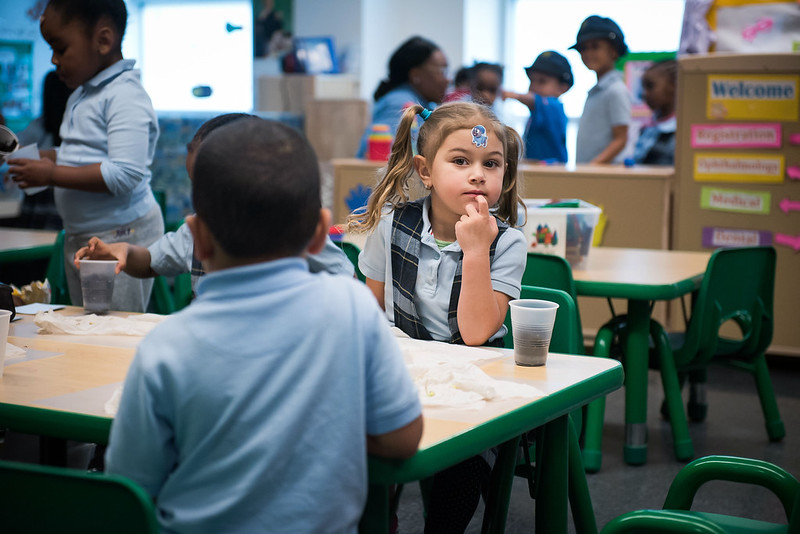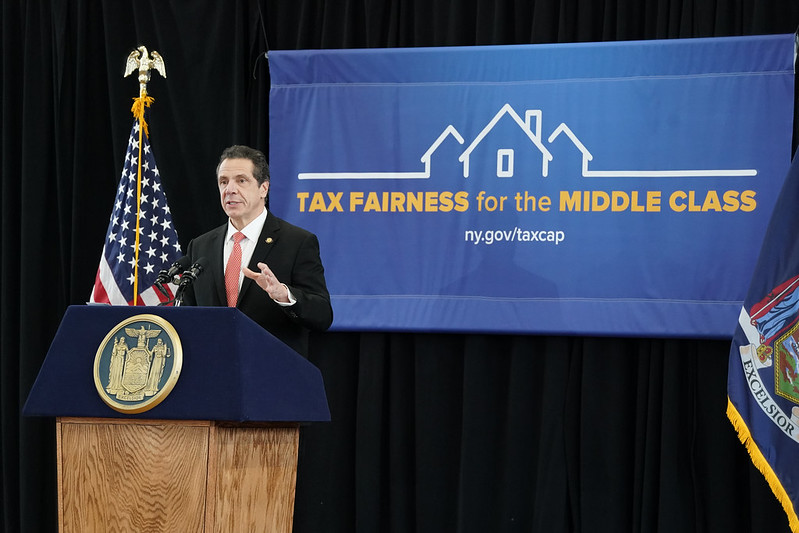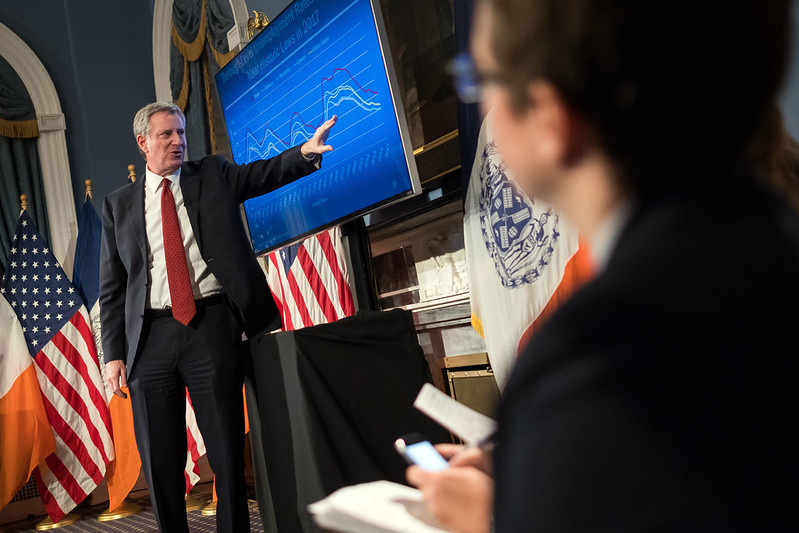Investing in New York City’s Future

Saving for college (photo: Michael Appleton/Mayoral Photography Office)
Across every borough, neighborhood, and community in New York City, families are united behind one wish: that their children will have the access and opportunity to fulfill their dreams. Making this wish a reality, however, is more complicated.
Increasingly, current household income determines a child’s future. Nationally, fewer than 10% of children from low-income households graduate from college, compared to nearly 80% from high-income households.
While programs like free college and student loan debt forgiveness are being debated nationally, statewide efforts like the Excelsior Scholarship have made college more affordable for some New York students, and CUNY provides affordable tuition options for many students, we need to provide support that can cover both tuition and non-tuition costs that pose barriers to higher education for many families.
To bridge the gap of what’s possible for New York City’s youth, we need meaningful collaboration among government, the private sector, philanthropy, and local communities to provide actual funding and support to increase college and career-training access. We need a universal college savings system for every New York City student.
For many New York families, post-secondary education is not even a possibility due to the astronomical costs. For those that do go, nearly 60 percent end up with debt averaging more than $31,000. There is also a stark socioeconomic disparity in savings: among New York City’s lowest-income neighborhoods, just one out of every 91 kindergarten students had a NY 529 savings account, while one in four kindergartners in the highest-income neighborhoods had a NY 529 account.
Having savings set aside for college and career training, from an early age, can have a profound impact on a child’s ability to attend, graduate, and obtain higher paying jobs. A child in a low-income household with modest savings - between $1 and $500 - has been shown to be three times more likely to go to college and four times more likely to graduate from college than a child without an account. This clearly demonstrates the power of early investment in student potential to succeed in the long term.
Here in Western Queens, students entering kindergarten in a public school in District 30 have been part of a ground-breaking pilot program that provides them with college savings accounts. Through the NYC Kids RISE Save for College Program, every kindergartener over the past three years has automatically received an NYC Scholarship Account with a $100 initial deposit. This has been made possible by The Gray Foundation.
While similar programs have been piloted in other cities and states, this program is unique in its community-driven, neighborhood-based approach that allows any person, company, community organization, or philanthropy to provide funding to participating students’ accounts. Some examples include the “Concert for College,” a “Donate the Change” campaign sponsored by Seamless, a $15,000 contribution by Brooklyn parents to participating students at P.S. 92 in Corona and the recent “Funding Long Island City’s Future” campaign. These community scholarships have added an additional $400,000 into student college savings accounts.
In addition, the Save for College Program works by partnering with all 39 elementary schools in District 30, the Department of Education, and community-based organizations. All partners work together to provide financial education and college-and-career resources, meeting parents and students locally to provide wrap-around support and information.
Beyond the monetary value, these investments and resources communicate an important message to our children that the community is supporting their future. This month, the third cohort of kindergartners and new first- and second-graders in District 30 were enrolled in this program. With the new cohort, the total number of students with college savings accounts through this program is more than 10,000.
We believe that every New York City community would benefit from this program. That’s why we are working together to bring universal college savings accounts citywide, to all 83,000 kindergarteners who enter the New York City public school each year. We will work with our colleagues in the City Council, the Mayor’s Office, our partners at NYC Kids RISE, and other philanthropic and nonprofit partners to support the expansion of this program to new communities and boroughs.
This universal college savings and community wealth building initiative will not only reduce the cost burden of higher education but also bring our communities together to invest in our city’s future. Please join us in showing our children that their communities have their backs.
***
City Council Members Danny Dromm, Costa Constantinides, Francisco Moya, and Jimmy Van Bramer represent different parts of Queens.
***
Have an op-ed idea or submission for Gotham Gazette? Email This email address is being protected from spambots. You need JavaScript enabled to view it.
Letter to the Editor: Raising Revenue for Medicaid and More

(photo: Governor's Office)
To The Editor,
I read with interest Gerald Benjamin's op-ed, Minding the Medicaid Gap, published on January 24, 2020. It's an excellent deep dive into the funding and administration of Medicaid at the state and local level.
I disagree, however, that raising taxes is necessarily unpalatable. Experts have identified ways to raise $40 billion in revenue, per year, by taxing New York's wealthiest individuals and corporations. Here's what we can tax, all without hurting Medicaid recipients, low- and middle-income families, and local governments:
-Second homes worth over $5 million
-Vacant luxury homes and commercial properties
-Annual Income over $5 million with additional tax brackets
-Carried interests (so hedge fund managers can't duck income taxes)
-Stock transactions
-Stock buybacks
-Companies that overcompensate CEOs
-Foreign companies that benefit from Trump tax breaks
Unlike a regressive sales tax, these revenue-raisers would only tax big corporations and the ultra-wealthy. This is how we can meet our state's needs for healthcare, housing, education, transportation, and climate justice. All we need is political courage on the part of Governor Cuomo and the New York State Legislature.
For readers who would like to learn more, nybudgetjustice.com, strongeconomyforall.org, and fiscalpolicy.org all offer information about these revenue-raising options.
Sincerely,
Carolyn Kelly
Manhattan
***
Have an op-ed idea or submission for Gotham Gazette? Email This email address is being protected from spambots. You need JavaScript enabled to view it.
The Mayor’s Savings Mirage

Mayor de Blasio presents a budget (photo: Ed Reed/Mayor's Office)
On January 20, Mayor de Blasio presented his $95.3 billion preliminary budget for the 2021 fiscal year that begins on July 1 as well as updated data on the budget for the current fiscal year. He noted that the Office of Management and Budget (OMB) and city agencies had found enough cost savings to completely offset the “new needs” spending included in the preliminary plan. The mayor praised this as an especially significant accomplishment since so much work has gone into finding savings in the administration’s prior budgets and the low-hanging fruit had already been picked.
Really? To channel former President Clinton, whether you think the savings plan is a success depends on what the meaning of “savings” is.
There is no question that Budget Director Melanie Hartzog and her staff take the effort to find efficiencies and improve government operations seriously. OMB’s city-wide savings unit provided a detailed description of the planned savings by agency. But even a casual review of the report reveals that most of the claimed $713 million “savings” over two years is in fact lower than projected interest on city debt and increases in revenue, not lasting cost savings achieved by cutting agency expenses.
Debt service reductions are the largest “savings” in the current fiscal year ($129 million) and were also the largest element in the savings plan totaling $474 million that was presented this past November. It is good news that the cost of borrowing continues to be lower than anticipated, but that is mostly a product of economic and market conditions, rather than an accomplishment of city administration. It would be more appropriate to apply savings in interest costs to paying down the city’s heavy outstanding debt than to use it to increase operating spending.
Another large category of claimed savings is actually new revenue. Most if it comes from collecting more reimbursements from the state and federal governments – called “reimbursement re-estimates.” This is money that is supposed to have paid for services already being delivered and should be used to offset those costs, not fund new programs. The plan also includes millions of dollars in higher fees and collections such as ambulance charges, elevator inspection fees, summons collections, as well as revenue from litigation settlements. If more money can be obtained by better enforcement of fines, fees, and penalties, that’s great (not everyone would agree), but that is not savings. Nor is moving costs from the expense to the capital budget, which is also included in the savings plan.
Some initiatives in the savings plan can truly be characterized as improvements in agency operations that optimize efficiency. But the number of these efficiencies to be achieved and their total dollar value are very small relative to the total value of the overall plan. Many of the initiatives are in the Department of Education, where reductions in the costly absent teacher reserve will save $39 million in unnecessary salaries, and there will be cost reductions in food service contracting and professional development.
Other promising efforts include trying to save on city phone service (to be overseen by DoITT), merging two divisions of the Department of Health & Mental Hygiene, and installing new upgraded software at CUNY. But the largest efficiency measure in the plan, $55 million in recurring procurement savings, is likely a placeholder to build up the savings total, not a real expectation of savings, since specifics of the reforms and how they will be implemented is not explained.
There is nothing wrong with saving city dollars through lower debt service, collecting more fines and fees, and getting the federal and state governments to provide more reimbursements. All of these things should be done; indeed they should be regular, ongoing efforts of city government that reduce the costs of current services.
The problem is in treating them as offsets to more spending, when most cannot be expected to recur, while the new spending will continue into the future and be incorporated into future years’ budgets. Meanwhile, the City Council will surely want to add more “new needs” to the budget for next year -- the mayor may also have some of his own -- and it appears that additional expenses due to cost-shifts from the state may well have to be absorbed. More real, significant, and sustained savings in city government are needed.
***
Carol Kellermann was president of Citizens Budget Commission from 2008 through 2018.
***
Have an op-ed idea or submission for Gotham Gazette? Email This email address is being protected from spambots. You need JavaScript enabled to view it.




